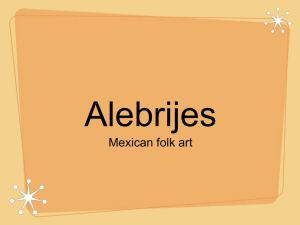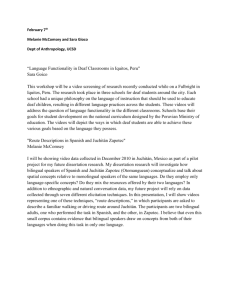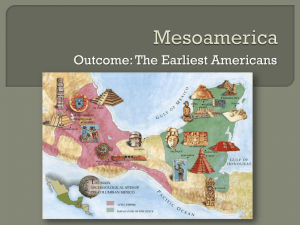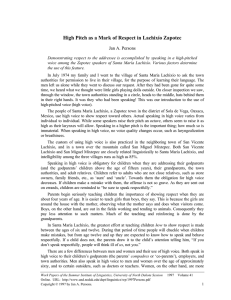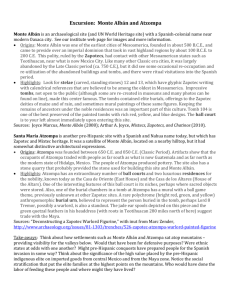Isthmus (Juchit´an) Zapotec ILLUSTRATIONS OF THE IPA
advertisement
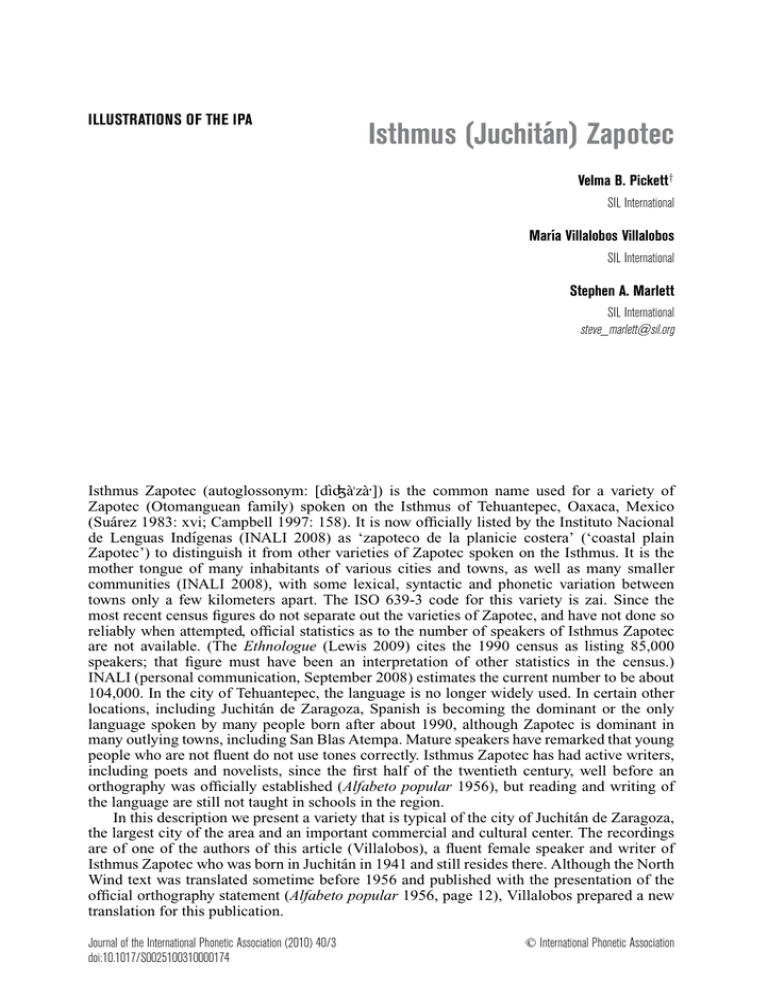
ILLUSTRATIONS OF THE IPA Isthmus (Juchitán) Zapotec Velma B. Pickett† SIL International Marı́a Villalobos Villalobos SIL International Stephen A. Marlett SIL International steve_marlett@sil.org Isthmus Zapotec (autoglossonym: [dı Ÿ a"z Ÿ aÚ]) Ÿ is the common name used for a variety of Zapotec (Otomanguean family) spoken on the Isthmus of Tehuantepec, Oaxaca, Mexico (Suarez ⁄ 1983: xvi; Campbell 1997: 158). It is now officially listed by the Instituto Nacional de Lenguas Indıgenas (INALI 2008) as ‘zapoteco de la planicie costera’ (‘coastal plain ⁄ Zapotec’) to distinguish it from other varieties of Zapotec spoken on the Isthmus. It is the mother tongue of many inhabitants of various cities and towns, as well as many smaller communities (INALI 2008), with some lexical, syntactic and phonetic variation between towns only a few kilometers apart. The ISO 639-3 code for this variety is zai. Since the most recent census figures do not separate out the varieties of Zapotec, and have not done so reliably when attempted, official statistics as to the number of speakers of Isthmus Zapotec are not available. (The Ethnologue (Lewis 2009) cites the 1990 census as listing 85,000 speakers; that figure must have been an interpretation of other statistics in the census.) INALI (personal communication, September 2008) estimates the current number to be about 104,000. In the city of Tehuantepec, the language is no longer widely used. In certain other locations, including Juchitan⁄ de Zaragoza, Spanish is becoming the dominant or the only language spoken by many people born after about 1990, although Zapotec is dominant in many outlying towns, including San Blas Atempa. Mature speakers have remarked that young people who are not fluent do not use tones correctly. Isthmus Zapotec has had active writers, including poets and novelists, since the first half of the twentieth century, well before an orthography was officially established (Alfabeto popular 1956), but reading and writing of the language are still not taught in schools in the region. In this description we present a variety that is typical of the city of Juchitan⁄ de Zaragoza, the largest city of the area and an important commercial and cultural center. The recordings are of one of the authors of this article (Villalobos), a fluent female speaker and writer of Isthmus Zapotec who was born in Juchitan⁄ in 1941 and still resides there. Although the North Wind text was translated sometime before 1956 and published with the presentation of the official orthography statement (Alfabeto popular 1956, page 12), Villalobos prepared a new translation for this publication. Journal of the International Phonetic Association (2010) 40/3 doi:10.1017/S0025100310000174 C International Phonetic Association 366 Journal of the International Phonetic Association: Illustrations of the IPA Published descriptions of the phonology of Isthmus Zapotec vary considerably – a fact that reflects the complexity of the situation. The first published detailed description of the sounds of Isthmus Zapotec was Pickett (1967), although discussion of the problems of the analysis was presented fifteen years earlier (Pickett 1951); see also Pickett & Embrey (1974). The analysis reflected in Marlett & Pickett (1987) is more in line with the analysis that underlies the official orthography utilized in publications such as Pickett et al. (1959/2007), Jimenez ⁄ Jimenez & Marcial Cerqueda (1997), and Pickett, Black & Marcial Cerqueda (2001). The ⁄ present description follows this same analysis. Consonants Stop Affricate Nasal Trill and Tap Fricative Approximant Lateral approximant Bilabial p b Alveolar t d m n… n r ɾ z s Postalveolar ʃ Palatal w Velar k j l… l For more than a half century, varieties of Zapotec have generally been described as having two series of consonants: strong vs. weak (Swadesh 1947), or fortis vs. lenis (see Leal 1950 and most work since then). The division of so-called fortis and lenis consonants in Isthmus Zapotec has been the following: Fortis: Lenis: p b t d k m n… n s z ʃ r ɾ w j l… l Note that the only sonorants displaying a fortis–lenis contrast are the alveolar ones. Examples of contrast between fortis and lenis sonorants are limited in number, with the fortis consonants /n…/, /r/ and /l…/ occurring in very few words. In word-initial position the contrast between fortis and lenis does not exist for sonorants except for the trill vs. tap contrast. The alveolar trill occurs in less than a half dozen words, including (in addition to those given in the consonant contrasts table) /ru#0ı#/ ["ru#0ı#] ‘a cut as in fruit or fish’ and /"rie#0nke#/ ["rı*e#0Nke#] ‘circles (game)’. Length is one of the characteristics of Isthmus Zapotec fortis consonants in trochaic foot-medial position, as in /upa# Ÿ / ["up…a# Ÿ ] ‘two’, /umı# Ÿ / ["um…ı# Ÿ ] ‘basket’ (see Conventions section below for more examples); fortis consonants are not long in other contexts. Voicing is one of the characteristics of Isthmus Zapotec lenis consonants, but relevant phonetically only for obstruents. Fortis obstruents are voiceless and lenis obstruents are voiced. Fortis stops may be slightly aspirated in the onset of a stressed syllable; this is not shown in the transcriptions in this article. Lenis stops vary to fricatives in many cases (see Conventions). V. B. Pickett† , M. Villalobos Villalobos & S. A. Marlett: Isthmus (Juchitán) Zapotec 367 Fortis and lenis consonants are also distinguished by the effect that they have on a preceding vowel in the trochaic foot. The vowel is shorter before a fortis consonant than before a lenis one (see Conventions). Some linguists have analyzed and represented Zapotec fortis consonants as geminates (see Swadesh 1947 for Proto-Zapotec); no current analysis of this type has been proposed and defended, however. Pickett (1967) posited a fortis/lenis contrast as well as a geminate contrast, but later abandoned this analysis in favor of the former in order to eliminate redundancy. The postalveolar fricatives are ‘slightly retroflexed, varying to clearly retroflexed in some idiolects’ (Pickett 1967: 293). A glottal fricative [h] occurs in three interjections besides being an allophone of /ʃ/ (see Conventions). A syllabic bilabial trill occurs in the archaic pronunciation of the word for ‘ant lion’ /beɾŸ e"nв! ʔ/. Ÿ / (archaic) ∼ /beɾŸ e"ndɾu! Ÿ Consonants are presented in two positions in the table of data illustrating the contrasts: word-initial position and word-medial position. p pe#suŸ ‘scar’ b tapŸ aŸ bel…Ÿ eŸ ‘flame’ kub Ÿ aŸ ‘dough’ t ‘four’ d tob Ÿ ıŸ ‘one’ ıtŸ uŸ ‘squash’ danı Ÿ # ‘hill’ zıdŸ ı Ÿ ‘salt’ k kub Ÿ aŸ ‘dough’ ıkŸ eŸ elŸ aŸ ‘head’ dia Ÿ aŸ ‘ear’ on…a# Ÿ ‘three’ ıı Ÿ # ‘thorn’ a#ʔ ‘full’ bia Ÿ ıŸ ‘plum’ ‘young corn plant’ Vowels Since the 1950s (see Alfabeto popular 1956 and Pickett et al. 1959/2007), the five vowels of Isthmus Zapotec have been described as occurring in three phonation types when in stressed syllables: modal, checked, and laryngealized. (Pickett 1967 backed away from this analysis, but subsequent work on Isthmus Zapotec did not.) Only one phonation type is found distinctively in a given morpheme. Checked vowels typically sound like a vowel that ends in a glottal stop; that is, in fact, an analysis that has been proposed by some linguists (see Swadesh 1947 and Esposito 2003, for example) and that is how they are represented (but not analyzed) here. We do not see glottal stop as a coda in this variety of Zapotec that otherwise has no closed syllables. Speck (1978) presents evidence for the vowel-feature analysis for Texmelucan Zapotec, arguing that the phonetic glottal stop does not pattern with syllable-final consonants with pronoun cliticization, for example (p. 71). Speck also reports that native speaker reaction in literacy efforts across the family has been consistent with treating this phonetic glottal stop as a vowel feature (Charles Speck, personal communication, June 2010). Nellis & Hollenbach (1980) provide additional arguments for the vowel-feature analysis for Cajonos Zapotec, as Avelino (2001) does for Yalalag Zapotec. Checked vowels in Isthmus Zapotec may also be ⁄ slightly laryngealized at times preceding the abrupt glottal closure, as in /koʔɾ Ÿ eʔ/ Ÿ [ko0Ÿʔɾeʔ] Ÿ ‘thigh’. Laryngealized vowels are slightly longer and typically pronounced with creaky voice. They are also sometimes pronounced with a clear rearticulation of the vowel after a weak 368 Journal of the International Phonetic Association: Illustrations of the IPA glottal stop, especially with low tone. Isthmus Zapotec does not have the breathy vowels found in some varieties of Zapotec such as Mitla (Stubblefield & Miller de Stubblefield 1991) and San Lucas Quiavinı ⁄ (Munro & Lopez 1999). See also Gordon & Ladefoged (2001), which includes a discussion of phonation types in some varieties of Zapotec, Esposito (2010), and Silverman (1997) for a discussion of phonation in Otomanguean languages more generally. Diphthongs are transcribed here as /ia/ [ı*a], /i0u/ [i0u*0], etc. i e u ı Ÿ ıʔŸ ‘fire’ lı Ÿ ıŸ ‘home (of)’ ‘excrement’ ıʔ Ÿ uʔ Ÿ ‘pimple’ ı Ÿ0 ‘nose’ dı Ÿ0aʔŸ ‘word’ beŸ leʔŸ ‘mold’ ezŸ aŸ eʔt Ÿ uʔ Ÿ ‘tobacco’ ‘fence’ ze0Ÿ ‘fresh corn’ e0Ÿ zeʔŸ ‘toasted corn meal’ (pinol) luluŸ ‘face’, ‘eye’ bup Ÿ uŸ ‘foam’ u#ʔ ‘outsider’ duʔ Ÿ aʔŸ ‘fig’ bu# 0 ‘charcoal’ u0Ÿ ıʔŸ ‘mucus’ ‘dead person’ Tones After considering different analyses, Pickett (1960) posited three phonemic tones for Isthmus Zapotec: High, Low, and Rising, and this analysis is reflected in the published vocabulary (Pickett et al. 1959/2007) and grammar (Pickett, Black & Marcial Cerqueda 2001); these three tones are used in the transcriptions in this illustration. Earlier work posited only High and Low (Pickett 1951), and later work posited these two organized as four pitch accents (Mock 1985, 1988). (Mock’s pitch-accent analysis is questioned in Yip 2002: 235–236.) Following an analysis similar to the one in Mock (1988), although many details remain to be worked out, we propose that the language may be better analyzed as having five tone melodies available for noun roots: High, Low, High-Low, Low-High, and Low-High-Low. How these five melodies are realized phonetically is dependent on the syllable profile of each morpheme, together with the influence of grammatical and phonological factors in the environment. Sometimes a Low-High combination appears on a single syllable. These melodies are demonstrated on monosyllabic and disyllabic nouns in the respective tone tables below as they appear in two situations: in isolation and in the context of the distal enclitic demonstrative /ka#/. V. B. Pickett† , M. Villalobos Villalobos & S. A. Marlett: Isthmus (Juchitán) Zapotec Melody H L LH HL Modal∗ Isolation In context (none) ı Ÿ ı Ÿ ka# ‘fire’ le# le# ka# ‘echo’ (none) Checked Isolation In context (none) baʔŸ baʔŸ ka# ‘tomb’ u#ʔ u# ka# ‘outsider’ (none) 369 Laryngealized Isolation In context (none) do0Ÿ do0Ÿ ka# ‘rope’ bu# 0 bu# 0 ka# ‘charcoal’ (none) ∗ We set aside monosyllabic nouns with modal diphthongs, for which examples of the melodies H, L, and LH (but not HL) are attested. Melody H L LH HL LHL Modal Penult Isolation In context ba#za# bazŸ aŸ ka# ‘arrow’ bızŸ uŸ bızŸ uŸ ka# ‘bee’ bea# beŸ aŸ ka# Ÿ ‘blackhead’ le⁄ uŸ le⁄ uŸ ka# ‘rabbit’ pe#suŸ ‘scar’ Checked Penult Isolation In context (none) beʔt beʔt Ÿ eʔŸ Ÿ eŸ ka# ‘skunk’ manŸ ıʔ⁄ manŸ ı ⁄ ka# ‘animal’ aʔn aʔn ⁄ aʔŸ ⁄ aŸ ka# ‘raccoon’ (none) Laryngealized Penult Isolation In context bu# 0bu# bu0Ÿ bu⁄ ka# ‘male grackle’ be0Ÿ ndaʔŸ be0Ÿ ndaŸ ka# ‘snake’ (none)∗ (none) (none) ∗ One example appears in the 2007 edition of Pickett et al. (1959/2007), but it is an error that was introduced in that edition. The word lanna (b.al) ‘olor a metal o a pescado’ (/lan…aʔ/ L.H ‘smell like metal or fish’) of earlier editions appears as the incorrect laana (b.al) /la0naʔ/ in the 2007 edition. Stress Stress has been posited for Isthmus Zapotec; it affects the length of the vowel itself (before lenis consonants), or the length of the consonant that follows (if it is fortis), or the tone (see Conventions). It usually falls on the penultimate (or the only) syllable of the root when the vowels are modal, although there are exceptions. Convincing examples clearly showing that the generalization is not appropriately stated as referring to the first syllable of the root are not easy to come by since stems longer than two syllables often seem to be compounds or to derive from compounds. The word /wakaaba/ [waka"aÚβa] ‘a particularly venomous tarantula’ may be an appropriate example. The weight of a syllable also affects the placement of stress. Final diphthongs attract stress: /bıi Ÿ a/Ÿ [bı"ı* Ÿ a]Ÿ ‘reed (otate)’. Final laryngealized vowels also attract stress: /un Ÿ a0Ÿ / [u"n Ÿ a0Ÿ ] ‘woman’. Stress does not occur on the prefix of a word. Enclitic pronouns are never stressed. The plural morpheme is a proclitic that appears before the noun or pronoun that it pluralizes; it is never stressed. Stress appears on the root /ne#/ in an example such as the following: /ɾı-ne# Ÿ kaŸ beŸ nı#/ [ɾı"ne# Ÿ Ú kaŸ beŸ nı#] (HABITUAL-carry PLURAL 3.HUMAN 3.INANIMATE) ‘they are carrying it’. In compounds and in phrases, the primary stress is generally the last one. The loss of primary stress in compounds (and sometimes in phrases) typically has the concomitant result of weakening or eliminating checking and laryngealization. Examples: /baʔd Ÿ uʔ/ Ÿ ["baʔd Ÿ uʔ] Ÿ 370 Journal of the International Phonetic Association: Illustrations of the IPA ‘child’, /wı0nŸ ıʔ/ Ÿ ["wı0nŸ ıʔ] Ÿ ‘little’, [badŸ uŸ "wı0nŸ ıʔ] Ÿ ‘baby’, /a0Ÿ paʔ/ Ÿ ["a0Ÿ paʔ] Ÿ ‘young woman’, [badŸ uŸ apŸ aŸ "wı0nŸ ıʔ] Ÿ ‘girl’. (In Pickett, Black & Marcial Cerqueda 2001 the compounds are written etymologically, but it is stated clearly that the phonetic facts are as presented here.) Also note that the autoglossonym given in the first paragraph of this paper illustrates this fact. Conventions Fortis consonants (sonorants as well as obstruents) are long when intervocalic following a stressed modal vowel in the same morpheme: /tapŸ a/Ÿ ["tap… Ÿ a]Ÿ ‘four’, /ıtŸ u/Ÿ ["ıt…Ÿ u]Ÿ ‘squash’, /ıkŸ e/Ÿ ["ık… Ÿ e]Ÿ ‘head’, /ıı# Ÿ / ["ı…ı# Ÿ ] ‘thorn’, /pe#su/Ÿ ["pe#s…u]Ÿ ‘scar’, /ıʃŸ e/Ÿ ["ıʃ… Ÿ e]Ÿ ‘hammock’, /umı# Ÿ / ["um…ı# Ÿ ] ‘three’, /be Ÿ e/Ÿ ["be… Ÿ e]Ÿ ‘mud’, /nawı# Ÿ / ["naw…ı# Ÿ ] ‘wears (long Ÿ ] ‘basket’, /on…a# Ÿ / ["on…a# skirt)’, /lajŸ a/Ÿ ["laj…Ÿ a]Ÿ ‘tooth’. Consonants in the enclitic pronouns are not long despite occurring after a stressed vowel: /ʃtı# tu#/ ["ʃtı#Ú tu#] (possession 2.PLURAL) ‘your (PL) possession, yours’. Lenis /b/, /d/ and // are commonly fricatives or approximants intervocalically, especially after modal vowels: /kub Ÿ ı]Ÿ ∼ ["zıÚŸ Dı]Ÿ ‘salt’, /ja Ÿ a/Ÿ ["jaÚŸ Ga]Ÿ ‘tree’, Ÿ a/Ÿ ["kuÚβ Ÿ a]Ÿ ‘dough’, /zıdŸ ı/Ÿ ["zıÚd and sometimes even in initial position. An initial // is often very weakly articulated, sometimes fricative, and often varies to something closer to [j] before /i/: /ıdŸ ı/Ÿ ["ıÚŸ Dı]Ÿ ∼ ["jıÚŸ Dı]Ÿ ‘leather’. A nasal has the same point of articulation as an immediately following consonant: /nga#/ ["Nga#Ú] ‘that one’, /ngolŸ a/Ÿ ["NgoÚlŸ a]Ÿ ‘male’, /ʃu#nku/Ÿ ["ʃu#ÚNku]Ÿ ‘youngest child’, /mbo# 0ta#/ ["mbo#0ta#] ‘huge’, /eɾ⁄ e/Ÿ [eÚɾ ⁄ e]Ÿ ‘deprecatory term for a Valley resident’. (See Marlett & Pickett 1987 for more discussion of phonotactics.) An exception is the archaic pronunciation of the word for ‘ant lion’ mentioned above which has an alveolar nasal before the syllabic bilabial trill: /beɾŸ e"nв! Ÿ /. Immediately preceding a nasal or lateral approximant, the sibilant /ʃ/ is most often phonetically the voiceless version of the sonorant. This is clearly seen when the derivational affix /ʃ-/ is added to simple nouns in order to derive a possessed noun: /nezŸ a/Ÿ ‘road’, /ʃnezŸ aŸ be#/ ["n9neÚz Ÿ ‘cot’, /ʃlu0ŸnaŸ be#/ ["l9lu0ŸnaŸ be#] ‘his/her cot’; compare /do0Ÿ/ Ÿ aŸ be#] ‘his/her road’; /lu0Ÿnaʔ/ ‘rope’, /ʃto0Ÿ be#/ [ʃto0Ÿ be#] ‘his/her rope’; /bıʔk Ÿ uʔ/ Ÿ uŸ xuan/ Ÿ uŸ xuan] Ÿ ‘dog’, /ʃpıʔk ⁄ [ʃpıʔk ⁄ ‘Juan’s dog’. Nevertheless, some fluent speakers use the allophone [ʃ] even before sonorants when /ʃ-/ is used in a less common derived situation; less fluent speakers also are likely to use exclusively [ʃ] except in monomorphemic situations. Many disyllabic words and some monosyllabic words have a pre-pausal form that is slightly different from the phrase-medial form; they end with glottal closure in pre-pausal position. (See Beam de Azcona 2008 for discussion of similar facts in another variety of Zapotec.) Because these words are pronounced and written by native speakers with the final glottal stop whenever the word is before a pause (including when given in isolation), these words are transcribed here phonemically with that glottal stop when given in isolation: /baʔd Ÿ aʔ/ Ÿ Ÿ uʔ/ Ÿ ‘child’ ["baʔd Ÿ uʔ] Ÿ (pre-pausal), ["baʔd Ÿ uŸ ka#] (child DISTAL) ‘that child’; /dı0 ‘word’ ["dı0 Ÿ aʔ] Ÿ aŸ ka#] (word DISTAL) ‘that word’, /u#ʔ/ ‘outsider’ [u#ʔ] Ÿ (pre-pausal), ["dı0 (pre-pausal), [u# ka#] (outsider DISTAL) ‘that outsider’. This glottal closure is an important realization, though usually redundant, of the glottal feature that is associated with the root. It is lost absolutely, however, when words with the LH melody are pronounced in context. Thus, the word for ‘animal’, for example, is claimed to be a LH melody word that has the feature for a checked vowel associated with it (see the second tonal contrast table). The final glottal stops that appear in the pre-pausal forms ["maÚn ⁄ ‘animal’ and ["et…Ÿ eʔ] Ÿ ıʔ] ⁄ ‘deep’ are typical and expected, as explained above. What is unusual about words of this tone melody is that the glottal feature does not ever appear on the stressed vowel of a disyllabic word, making the analysis of those words somewhat opaque since in context they have no glottal feature evident; see ["maÚn Ÿ ı ⁄ ka#] (animal DISTAL) ‘that animal’ and ["et…Ÿ e⁄ nı#] (deep 3.INANIMATE) ‘it is deep’. Stressed modal vowels are slightly longer when they precede a lenis consonant or word break (see also Ward, Zurita Sanchez & Marlett 2009 for Quioquitani Zapotec; but contrast ⁄ V. B. Pickett† , M. Villalobos Villalobos & S. A. Marlett: Isthmus (Juchitán) Zapotec 371 with Avelino 2001 for Yalalag ⁄ Zapotec): /kub Ÿ a/Ÿ [kuÚβ Ÿ a]Ÿ ‘dough’, /gıdŸ ı/Ÿ ["gıÚŸ Dı]Ÿ ‘leather’, /jag Ÿ a/Ÿ [jaÚŸ Ga]Ÿ ‘tree’, /bia Ÿ ı/Ÿ ["bı*aÚ Ÿ ı]Ÿ ‘plum’, /nezŸ a/Ÿ ["neÚz Ÿ a]Ÿ ‘road’, /le⁄ u/Ÿ ["leÚ ⁄ u]Ÿ ‘rabbit’, /ʃono# Ÿ / ["ʃoÚno# Ÿ ] ‘eight’, /beɾŸ e/Ÿ ["beÚɾ Ÿ e]Ÿ ‘hen’, /elŸ a/Ÿ ["eÚlŸ a]Ÿ ‘young corn plant’, /ı/Ÿ ["ıÚ]Ÿ ‘fire’, /ʃtı# tu#/ ["ʃtı#Ú tu#] (possession 2.PLURAL) ‘your (PL) possession, yours’. An acoustic study of the vowels of Isthmus Zapotec (Martin 2010) shows that the vowels /a/, /e/, and /u/ have centralized allophones when they are unstressed. Low tone starts slightly lower in unstressed pre-pause syllables, whereas in stressed syllables it typically has a sharp fall to lower (not represented here): /nezŸ a/Ÿ ["neÚz Ÿ a]Ÿ ‘road’, /baʔd Ÿ [badŸ uŸ apŸ aŸ "wı0nŸ ıʔ] Ÿ ‘girl’. Ÿ uʔ Ÿ a0pŸ aʔŸ wı0nŸ ıʔ/ Transcription of the recorded passage tı Ÿ ı Ÿ kakŸ a0Ÿ ju⁄ bı Ÿ jo0⁄ʃoŸ ne# gub Ÿ aŸ tuŸ tob Ÿ ı Ÿ ı Ÿ deŸ la0kŸ aŸ ʃma⁄ nadŸ ıpŸ aʔ⁄ ɾake# Ÿ nu#0 ka# bedŸ anda# tı Ÿ ngı0uŸ ɾe#nda# tı Ÿ laɾŸ ı Ÿ ngolŸ aŸ paɾŸ aŸ un Ÿ aŸ kaʔŸ | uʔj Ÿ ıʔŸ stı0 Ÿ aŸ kaʔŸ tuŸ la0⁄ Ÿ ubi# ne# st al…e# st ıp a aʃŸ aʔ⁄ laɾŸ ı Ÿ ladŸ ı Ÿ nı0uŸ ke# bızŸ u"lŸ uŸ ndaʔŸ bı Ÿ jo0⁄ʃoŸ bınd Ÿ Ÿ ⁄ Ÿ peɾŸ uŸ laa# Ÿ Ÿ ʃma⁄ nadŸ ıpŸ a⁄ la⁄ kund ⁄ ı Ÿ tı Ÿ bı Ÿ Ÿ nda# ı0 Ÿ ı Ÿ nı0uŸ ke# ʃabŸ aŸ nı Ÿ bıʔn Ÿ ubi# Ÿ la⁄ | ʃma⁄ ɾusi# Ÿ bıɾe# la⁄ | bia0nŸ a# i# o#ɾake# Ÿ aŸ bızŸ a0nŸ ı Ÿ ne# ı"ɾa# Ÿ ʃtuʃ⁄ uŸ o#ɾake# Ÿ bızŸ u"lŸ uŸ ub Ÿ ı Ÿ ka# ule# Ÿ 0 nı0uŸ keŸ ʃab⁄ aŸ | ne# zaka# Ÿ aŸ ke# la0Ÿ Ÿ bı0jŸ aʔŸ | bı Ÿ ʃma⁄ nadŸ ıpŸ a⁄ ub Ÿ ı Acknowledgements We thank John Alsop, Rosemary Beam de Azcona, Cheryl Black, Virginia Embrey, Maritza Elena Enrıquez Licon, Crispın, ⁄ ⁄ Vicente Marcial Cerqueda, Elizabeth Merrill, Allison ⁄ Mariano Lopez ⁄ Polsley, Keith Snider, Charles Speck, an anonymous reviewer, and editor John Esling for their help on this article. We especially thank John Alsop for his help with the majority of the recordings and Keith Snider for his guidance on the analysis and presentation of the tone melodies. References Avelino, Heriberto. 2001. The phonetic correlates of fortis–lenis in Yalalag Zapotec consonants. MA ⁄ thesis, University of California, Los Angeles. Alfabeto popular para la escritura del zapoteco del Istmo. 1956. Mexico City: La Sociedad ProPlaneacion & Instituto Lingüıstico de Verano. ⁄ ⁄ ⁄ Integral del Istmo, El Consejo de Lenguas Indıgenas, http://www.sil.org/mexico/zapoteca/istmo/l073-alfpopzapistmo-zai.htm (30 July 2008). Beam de Azcona, Rosemary G. 2008. Un estudio comparativo de los tonos del zapoteco sureño. In Ausencia Lopez Cruz & Michael Swanton (coords.) Memorias del Coloquio Francisco Belmar, 161– ⁄ 185. Conferencias sobre lenguas otomangues y oaxaqueñas, vol. II. Oaxaca, Mexico. Campbell, Lyle. 1997. American Indian languages: The historical linguistics of Native America. New York & Oxford: Oxford University Press. Esposito, Christina M. 2003. Phonation in Santa Ana del Valle Zapotec. MA thesis, University of California, Los Angeles. Esposito, Christina M. 2010. Variation in contrastive phonation in Santa Ana Del Valle Zapotec. Journal of the International Phonetic Association 40(2), 181–198. Gordon, Matthew & Peter Ladefoged. 2001. Phonation types: A cross-linguistic overview. Journal of Phonetics 29, 383–406. INALI (Instituto Nacional de Lenguas Indıgenas). 2008. Catalogo de las lenguas indıgenas nacionales: ⁄ ⁄ ⁄ Variantes lingüısticas de Mexico con sus autodenominaciones y referencias geoestadısticas. ⁄ ⁄ ⁄ http://www.inali.gob.mx/catalogo2007/html/v_zapoteco.html (9 September 2008). Jimenez Jimenez, Enedino & Vicente Marcial Cerqueda. 1997. Neza diidxa’: vocabulario zapoteco. ⁄ ⁄ Juchitan, ⁄ Oaxaca, Mexico: Centro de Investigacion ⁄ y Desarrollo Binniza.⁄ 372 Journal of the International Phonetic Association: Illustrations of the IPA Leal, Mary. 1950. Patterns of tone substitution in Zapotec morphology. International Journal of American Linguistics 16(3), 132–136. Lewis, M. Paul (ed.). 2009. Ethnologue: Languages of the world, 16th edn. Dallas, TX: SIL International. http://www.ethnologue.com (18 November 2009). Marlett, Stephen A. & Velma B. Pickett. 1987. The syllable structure and aspect morphology of Isthmus Zapotec. International Journal of American Linguistics 53(4), 398–422. Martin, Julia M. 2010. Isthmus Zapotec formants. Work Papers of the Summer Institute of Linguistics, University of North Dakota Session 50. http://www.und.edu/dept/linguistics/wp/2010Martin.PDF. Mock, Carol. 1985. A systemic phonology of Isthmus Zapotec prosodies. In James Benson & William Greaves (eds.), Systemic perspectives on discourse: Selected theoretical papers from the 9th International Systemic Workshop, 349–373. Norwood, NJ: Ablex. Mock, Carol. 1988. Pitch accent and stress in Isthmus Zapotec. In Harry van der Hulst & Norval Smith (eds.), Autosegmental studies on pitch accent, 197–223. Dordrecht & Providence, RI: Foris. Munro, Pamela & Felipe H. Lopez. 1999. Di’csyonaary X:tèe?n Dı̀izh Sah Sann Lu’uc. San Lucas Quiavinı́ Zapotec dictionary, Diccionario zapoteco de San Lucas Quiavinı́. Los Angeles, CA: Chicano Studies Research Center. Nellis, Donald G. & Barbara E. Hollenbach. 1980. Fortis versus lenis in Cajonos Zapotec phonology. International Journal of American Linguistics 46(2), 92–105. Pickett, Velma B. 1951. Nonphonemic stress: A problem in stress placement in Isthmus Zapotec. Word 7, 60–65. Pickett, Velma B. 1960. The grammatical hierarchy of Isthmus Zapotec. Language 36(1), supplement, part 2. Pickett, Velma B. 1967. Isthmus Zapotec. Linguistics. In Norman A. McQuown (ed.), Handbook of Middle American Indians, vol. 5, 291–310. Austin, TX: University of Texas Press. Pickett, Velma B. et al. 1959/2007. Vocabulario zapoteco. Mexico City: Instituto Lingüıstico de Verano. ⁄ [1st edn. 1959, 5th edn. 2007; 5th edn. online: http://www.sil.org/mexico/zapoteca/istmo/S003cVocZapIstmoEd5-zai.pdf (30 July 2010).] Pickett, Velma B. & Virginia Embrey. 1974. Zapoteco del Istmo (Archivo de Lenguas Indıgenas del Estado ⁄ de Oaxaca). Mexico City: Instituto de Investigacion ⁄ e Integracion ⁄ del Estado de Oaxaca, El Colegio de Mexico & Instituto Lingüıstico de Verano. ⁄ ⁄ Pickett, Velma B., Cheryl Black & Vicente Marcial Cerqueda. 2001. Gramática popular del zapoteco del Istmo, 2nd edn. Oaxaca, Mexico & Tucson, AZ: Centro de Investigacion ⁄ y Desarrollo Binniza⁄ & Instituto Lingüıstico de Verano. http://www.sil.org/mexico/zapoteca/istmo/G023a⁄ GramaticaZapIstmo-ZAI.htm (30 July 2010). Silverman, Daniel. 1997. Laryngeal complexity in Otomanguean vowels. Phonology 14, 235–261. Speck, Charles H. 1978. The phonology of Texmelucan Zapotec verb irregularity. MA thesis, University of North Dakota. Stubblefield, Morris & Carol Miller de Stubblefield. 1991. Diccionario zapoteco de Mitla, Oaxaca. Mexico City: Instituto Lingüıstico de Verano. ⁄ Suarez, Jorge. 1983. The Mesoamerican Indian languages. Cambridge: Cambridge University Press. ⁄ Swadesh, Morris. 1947. The phonemic structure of Proto-Zapotec. International Journal of American Linguistics 13(4), 220–230. Ward, Michael, Emiliano Zurita Sanchez & Stephen A. Marlett. 2009. Quioquitani Zapotec. In Stephen ⁄ A. Marlett (ed.), Ilustraciones fonéticas de lenguas amerindias, 1–9. Lima, Peru: SIL International & Universidad Ricardo Palma. www.lengamer.org/publicaciones/trabajos/zapoteco_de_Quioquitani_afi. pdf (30 July 2010). Yip, Moira. 2002. Tone. Cambridge: Cambridge University Press.
